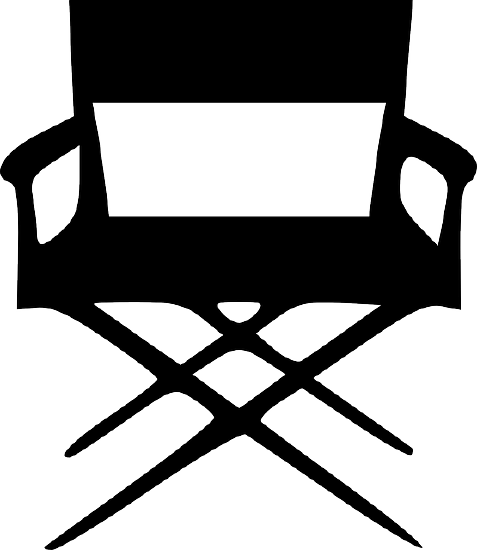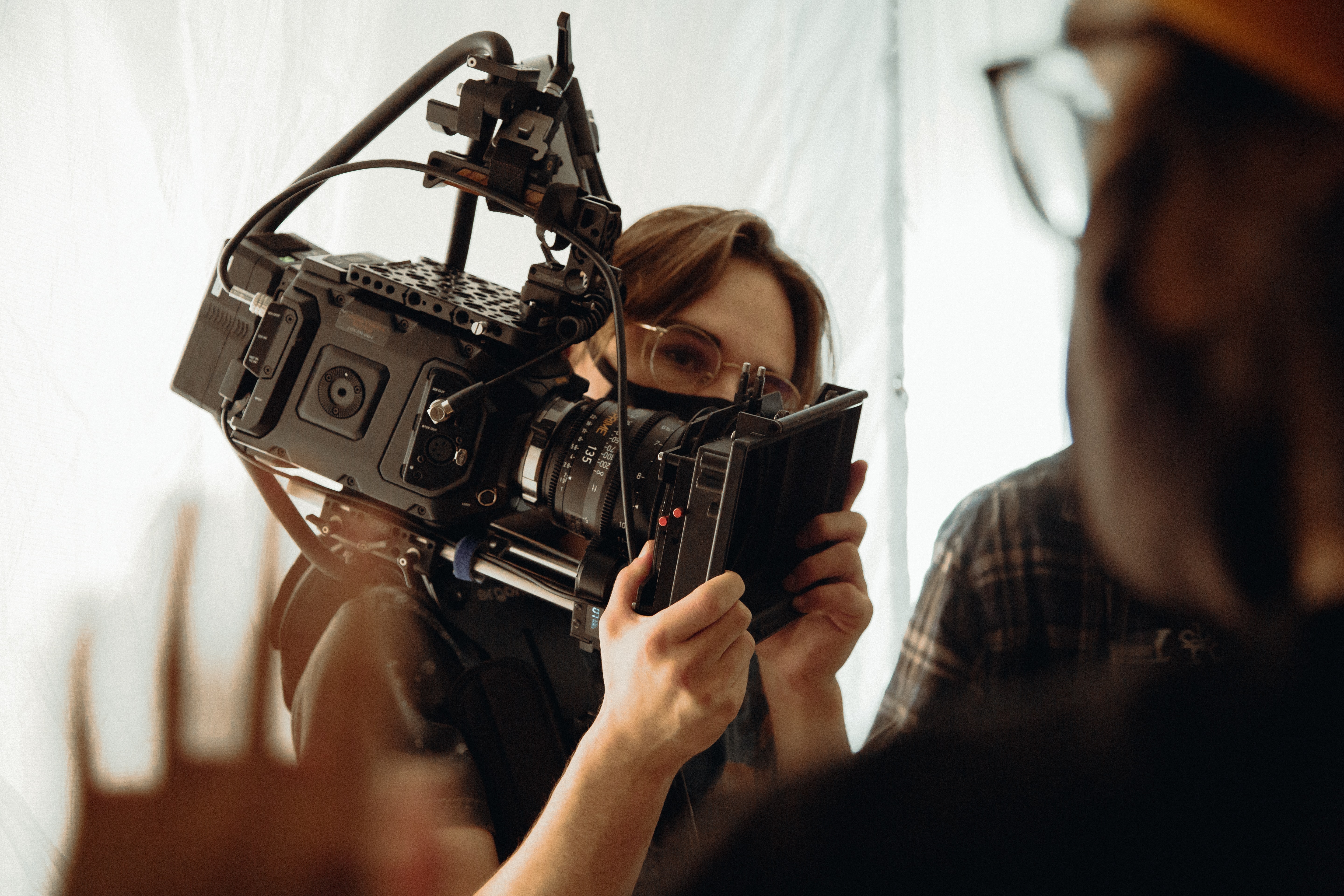6.1: Who Does What
- Page ID
- 120173
...And Finally on the Set
The long preproduction has come to this, actually putting to action all of the careful planning. Think of production as two main bodies of consideration: the actions of the talent (actors or interviewees if a documentary); and the actions of the crew. These positions are controlled by the Director and Director of Photography (DP) respectively. A single person crew would be tasked to fill every production position.

As the crews sizes grow, video production jobs on the set get more defined: those affecting the talent directed by the director; and those of the more technical cameras, lights, and sound supervised by the DP. Since producers overview everything on a production, two-person crews would also split up the duties of the producer.
It is best to determine job functions before getting to the set, especially if there is talent or interviews to be done. The more organized the approach to production the smoother things will go. If the actors are comfortable with the actions of the crew then their performances will be better. This is especially true with first-time interviewees nervous before a camera. All those in front of the camera want to be seen in a good light and depend on the crew to protect their images and reputations.
A good strategy for a two-person crew has the director working with talent, blocking the scenes, going over lines, going over interview questions for documentaries, and making sure all the talent releases have been signed. While the director of is involved with on-camera talent, the DP can light the scene, prepare the mikes, and set up the camera.
At some point the director and DP come together to make sure the talent blocking and camera angles make sense. There may be a rehearsal before an actual take which may be filmed as well. This way the director-DP team can see a playback before doing a real take.
As crew are added they would be deployed to assist either the director or DP. As the number of crew increases, the jobs get more specialized.
By splitting the duties between directing the talent and directing the technical crew, the director and DP should not be considered equal in responsibility. The overall control of productions belongs to the director. The DP still reports to the picture director whose decision is final.

The Director's Role
The Director is the orchestra leader, responsible to show superior images on screen. The director coaxes the best performances of the actors, automobiles and animals while making sure the cameras record these scenes. The director works closely with the DP to set up the best angles that support the film’s themes.
Since the actors, interviewees, animals, and sets are what an audience will see on screen, the performance behind the camera needs to be organized and professional. An actor’s image is how they get future rolls - how they look onscreen is important. Actors need to trust that the crew is looking to support the best performance. A person being interviewed on camera needs to have confidence that what they say is being translated to an audience.
Crew may be hired to assist the director. They are credited as the first and second assistant directors or production assistants.
The First Assistant Director (1st AD)
The 1st AD is responsible for breaking down the script and putting in into a shooting schedule. This involves looking at the script and breaking it down to individual scenes and shots, and creating a labeling convention for the scenes. The 1st AD keeps track of the schedule making sure the shoots run efficiently.
The Second Assistant Director (2nd AD)
The 2nd AD assists the 1st AD on set. They are also responsible for the paperwork such as the call sheets and production reports. They are the conduit to the cast, getting them to the set at the proper time, and delivering information about changes to the shooting schedule.
Production Assistants
Production assistants assist the 1st and 2nd ADs, generally doing all the odd jobs so no details slip by.

The Director or Photography (DP or DoP)
Obviously, the DP supervises the camera shots - they also manage the lighting department, audio recording, grips, gaffers and electricians.
The director of photography, sometimes called the cinematographer, partners with but generally works for the director. This person is responsible for realizing the director's vision onto the film, TV program or whatever the filmed production needs. The cinematographer heads the camera, lights, electrician and set crews. Pretty much anything having to do with the image, from selecting the camera and lenses to the look of the lighting.
There is a close bond between the director and DP, but the director's decisions are where the proverbial buck stops. A director can let the cinematographer freely make image decisions. While some directors take charge of camera placement, these two roles need to have the best working relationship to keep productions orderly and efficient.
The First Assistant Camera (1st AC, sometimes referred to as the Focus Puller)
The 1st AC main job is to keep the image in focus. On a lock down shot when the subject does not move, they can simply set focus, then check focus before the camera rolls. For more complex shots, the 1st AC needs a strategy that follows the focus as the subject moves closer and further away from the camera. There are specialized equipment either attached to the camera (like a focus ring) or by remote that can assist this focus puller in their job.
Keeping a moving shot in focus is a tough job and may take a rehearsal or two before a live take. Once the camera rolls, the focus puller needs to stay alert to the action. No two takes are exactly alike. The 1st AC must concentrate on keeping the talent sharp in focus or ruin an otherwise good take.
The 1st AC is responsible for the care and maintenance of the camera equipment. This involves assembling camera rigs, setting tripods, cleaning camera lenses, and striking and boxing up the equipment at the end of the day.

The Second Assistant Camera (2nd AC)
The main role of the 2nd AC is to run the clapper board or slate. Slates mark the beginning and sometimes the end of each shot. Words and numbers on the slate change from each take and identifies the scene for the post production team. To keep things straight there needs to be a naming convention (generally which rolls, scenes, and takes) that relates back to the script, and a way to distinguish good takes from bad ones. So there is usually a written or digital record that keeps track of this information when the shot has stopped. The slate is called a "clapper board" because a section of the top is hinged and can be raised and "clapped down" to make a one-frame sound. This one frame assists the post production editor sync audio recorded on an external device with picture. There is a short video demonstration in the final section of this chapter which shows the clapper board in action.
Additional tasks that the second AC owns on set include:
- During talent blocking, creating floor marks which assist the 1st AC with beginning and end marks for focus pulls.
- Keeping a database of every shot with notes about camera settings and whether all or part of the shot is usable.
- Assisting the 1st AC in maintaining and organizing camera gear.
The Lighting Director
On smaller crews, the cinematographer acts as the lighting director. They are responsible for the look of the shots and overall cinematic look of the picture. They need to make the actors look good, create a mood to the sets and scenery, and to support the features themes.
Where there is a separate crew member, the lighting director works closely with and reports to the Director of Photography.
The Digital Imaging Technician (DIT)
This relatively new position in production is the result of the complex demands of moving the digital production files created on a shoot to the editor. DITs support the camera and audio teams with technical and creative tasks such as making SD card and hard drive backups and quality checks of the footage. DITs keep track of shooting formats, file exports, color grading (providing LUT information to the editor), and they create the working copies for the directors and producers.
Other Positions under the DP

- Camera operator: Sometimes a separate person other than the DP operates the camera. In these cases the DP watches the take on a separate monitor.
- Dolly grip: Cameras are not always handheld or on tripods. There are other methods of camera support and some, like dollys, need crew to push and pull the supports during takes. A dolly grip moves these devices.
- Grip: Extra persons assigned to the camera crew for hauling, setting up, and striking equipment. Usually an entry level position.


